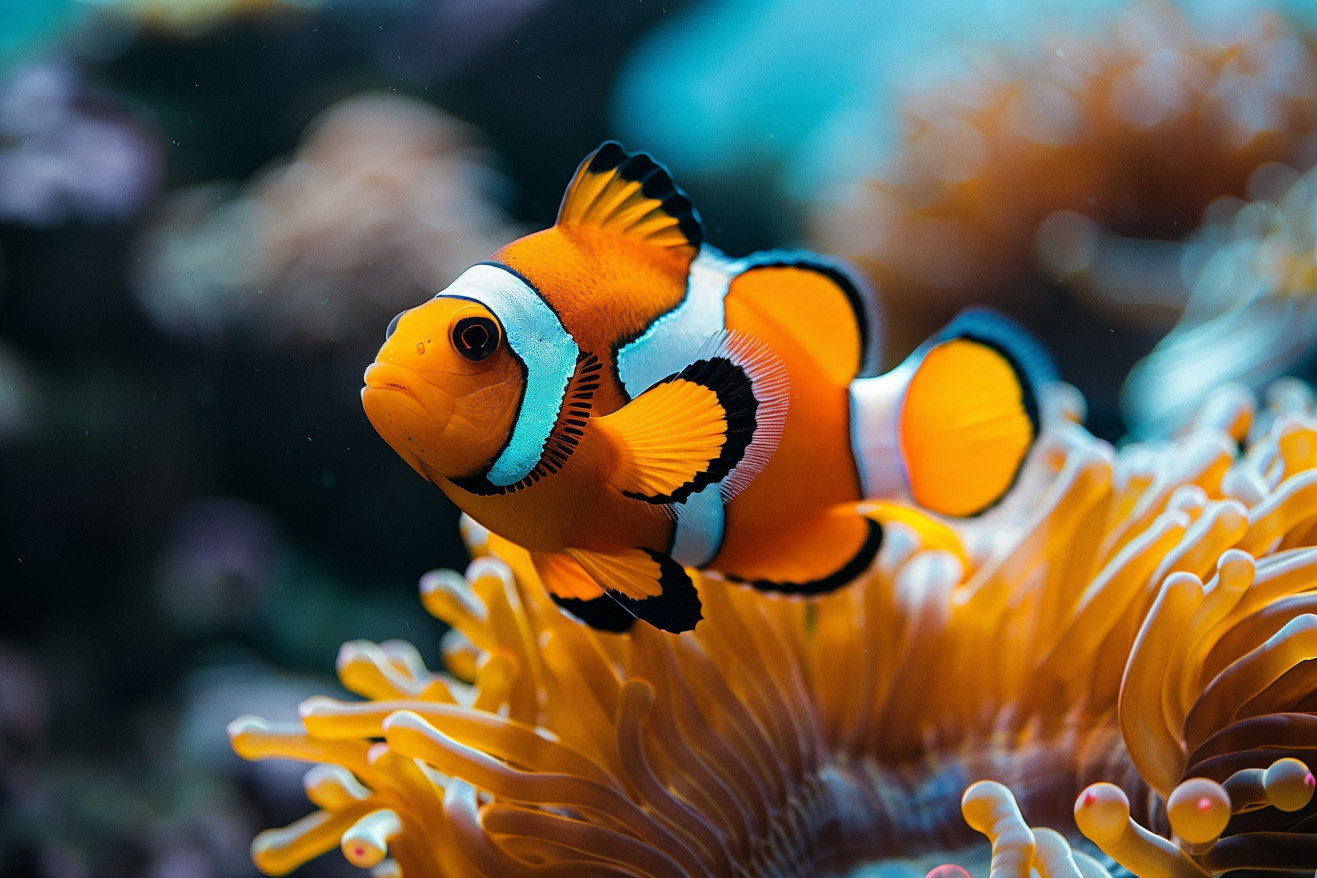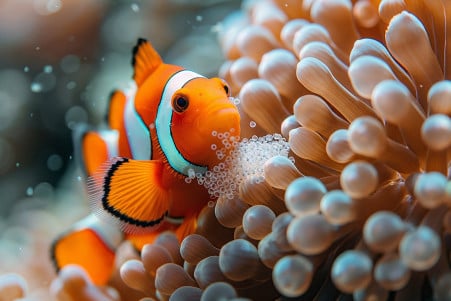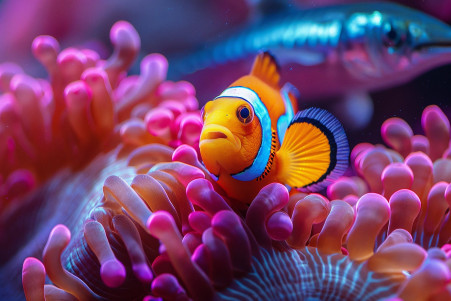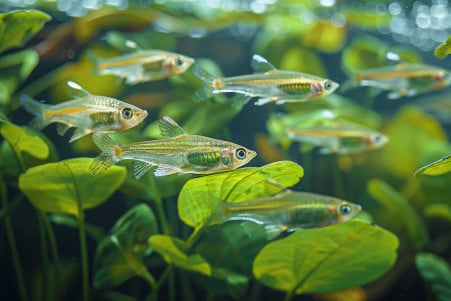What Do Clownfish Eat? Unveiling Their Ocean Diet and Captivity Feeding
20 February 2024 • Updated 19 February 2024

As they dart in and out of the vibrant tentacles of sea anemones, what are clownfish eating in the wild? Clownfish have a varied diet that includes zooplankton, small crustaceans, and algae. In captivity, they eat marine pellets, frozen foods such as Mysis shrimp, and even some vegetables, which provides a well-rounded, omnivorous diet that includes both protein and plant matter.
In this article, we will explore the clownfish diet by looking at marine biology and aquarium care research to learn about what clownfish eat in the wild and in captivity. We will also discuss how their symbiotic relationship with sea anemones impacts their diet and how this relationship ensures that they get the nutrients they need.
By combining these sources, we hope to provide a complete resource for keeping these popular marine fish healthy and happy.
What do clownfish eat?
Foraging Amongst Anemones: The Diverse Diet of Wild Clownfish
In the wild, clownfish are foraging generalists, eating a wide variety of foods. According to American Oceans, they primarily eat small zooplankton, algae, and a variety of small crustaceans, which shows that they are omnivorous. Clownfish take advantage of the protective relationship they have with sea anemones by using them as both a safe haven and a feeding station, eating the remains of the anemone’s prey, which often includes mussels and other shellfish.
The Indian and Pacific Oceans provide a wide range of options for clownfish, and there are even regional differences in the foods available to them. For example, in coral reefs, clownfish may eat zooplankton, while in lagoons, they may eat more plant material.
In addition, seasonal and other environmental changes can also affect what food is available to clownfish and how much they can eat. As described in American Oceans, the relationship between clownfish and their host anemones ensures that clownfish will always have a reliable source of nutrients, no matter what else is going on in their ever-changing environment.
This rich and varied diet is what clownfish rely on in the wild, and it also helps determine how they should be fed in captivity to make sure they get all the nutrients they need to be healthy in their underwater environment.
How to Feed Clownfish in Your Aquarium
To feed clownfish in a saltwater tank, you need to provide them with a diet that closely resembles the one they would have in the wild. This is important for their overall health and well-being. FishLab says a well-rounded diet for clownfish in an aquarium should include marine pellets, frozen foods like mysis shrimp, and even vegetables to make sure the fish don’t develop nutritional deficiencies.
When it comes to baby clownfish, they need to be fed more often and should be given a diet of crushed flakes or pellets.
FishLab recommends feeding adult clownfish twice a day, while younger fish should be fed three to four times a day. Hepper says that a diet of crustaceans, marine fish food, and vegetables like nori and spirulina algae will ensure that the fish are getting the variety they need. However, overfeeding can lead to problems like algae blooms and water quality issues in your tank.
Even with the best of intentions, it’s easy to feed your clownfish the wrong amount of food. The Maryland Aquarium Design, Installation, and Maintenance team says that a good rule of thumb is to feed clownfish a portion of food that’s about the size of their eye, as larger portions are a common mistake.
By following these guidelines, you can make sure that your clownfish get the nutrition they need to thrive, just like they would in the wild when they’re foraging for food in the tentacles of their anemone homes.
An Underwater Alliance: The Mutualism of Clownfish and Sea Anemones
In the complex world of the coral reef, there are few relationships that better exemplify mutualism than the one between clownfish and sea anemones. These partners have evolved to thrive in a symbiotic relationship that provides both with valuable advantages.
For example, clownfish have a special mucus that protects them from the stings of anemone nematocysts, which enables them to live among the anemone’s tentacles that would otherwise be deadly to other fish. This adaptation allows the clownfish to gain both protection and food, as they can eat the detritus from the anemone’s meals, according to AskNature.
In exchange, clownfish serve as the anemone’s caretakers. They protect the anemone from predators that would eat it, help to improve the anemone’s oxygen levels by increasing water flow, and provide the anemone with nutrients through their waste, which is high in ammonia, according to the National Marine Sanctuary Foundation. This results in the anemone growing faster and healthier, which in turn provides the clownfish with a safe place to live.
This relationship also impacts the clownfish’s feeding behavior, as the anemone’s protection allows the clownfish to forage more boldly.
This relationship also shows how delicate the balance of the ocean is and how important it is to protect these relationships in the ocean, which can inform conservation and even industrial resource management like the Kalundborg Symbiosis model. As more research is done on the nutritional needs of clownfish, the impact of this mutualism becomes even more clear.
What Do Clownfish Eat in the Wild?
Protein is important for growth and a healthy immune system and is therefore a key component of a clownfish’s diet. According to Beginner Fish Tank, small marine crustaceans and brine shrimp are great sources of protein, and the healthy fats found in these foods help clownfish maintain their bright colors and high energy levels.
Vitamins and minerals are also important, with vitamin C being important for bone health, phosphorus and calcium being important for overall health, and fiber being important for digestion.
FishChart recommends feeding a combination of live, frozen, and dry foods, including commercially prepared pellets and flakes, to ensure that your clownfish gets all of the nutrients it needs. There are many different types of food that are available for clownfish, including brine shrimp, mysis shrimp, and seaweed-based flakes, all of which are important for providing the vitamins and minerals that are important for a healthy life underwater, according to Fishkeeping World.
Not only is a balanced diet important for the health and well-being of clownfish, but it’s also important for their activity levels and for maintaining their bright colors. In captivity, aquarists can add supplements to their clownfish’s diet to ensure that they get the variety and nutrition that they would get in the wild, which will help them stay healthy and happy.
By focusing on providing a diet that’s both varied and nutritionally complete, aquarium hobbyists can help ensure that clownfish remain healthy and vibrant, which leads to a larger discussion about the ecological implications of their diet and well-being.
The Fragile Equilibrium: Human Impact and Clownfish Resilience
The well-being of clownfish is tied to the health of their environment, and human activities are increasingly threatening the reefs where they live. An article in Forbes describes a study that found light pollution has a dramatic effect on clownfish reproduction, with artificial light preventing their eggs from hatching.
Meanwhile, an article in The Guardian reports that light pollution makes young clownfish more susceptible to predators, which results in lower survival rates and smaller sizes.
These studies highlight the larger impacts of human-induced change—pollution, climate change, and overfishing—that are disrupting the fragile ecosystems clownfish rely on. Changes in light, water quality, and food availability can lead clownfish to change their feeding habits or face dire consequences. If their natural diet is no longer available, clownfish may not be able to find the food they need to survive.
Human intervention has the potential to make a difference. By reducing pollution, preventing overfishing, and working to slow the impacts of climate change, we can help protect the complex web of life in the ocean.
Sustainable solutions, like the one proposed in a study in Royal Society Publishing that calls for the regulation of artificial light in coastal areas, are essential to ensuring the survival of clownfish. As we look ahead to their future, it’s important to remember that human actions play a key role in protecting these colorful marine creatures.
Cultivating the Rainbow Reefs of Clownfish
In reviewing the dietary needs of clownfish, we have seen the diversity of their natural diet in the wild, which includes everything from zooplankton to algae, and how that diet is replicated in captivity with pellets, frozen food, and vegetables.
We have also seen how the mutualistic relationship with sea anemones, which is so central to the clownfish diet, benefits both the clownfish and the anemones. The anemones provide the clownfish with protection and additional food sources, while the clownfish provide care for the anemones.
It is therefore important to provide a well-rounded diet that includes proteins, fats, and vitamins to help maintain their bright colors and active behavior.
The marine environments where clownfish live are under constant threat from pollution and climate change, which can disrupt their natural feeding patterns. This means that we must be mindful of our impact on their environment. By learning about and supporting their nutritional needs and their relationship with their anemone hosts, we can help ensure their survival and make positive changes in our own lives.
In the end, let’s remember that every choice we make matters, from the care of our aquariums to the way we treat the environment as a whole. Clownfish are not only beautiful but also a symbol of the interconnectedness of the world under the sea and our responsibility to help sustain it.


